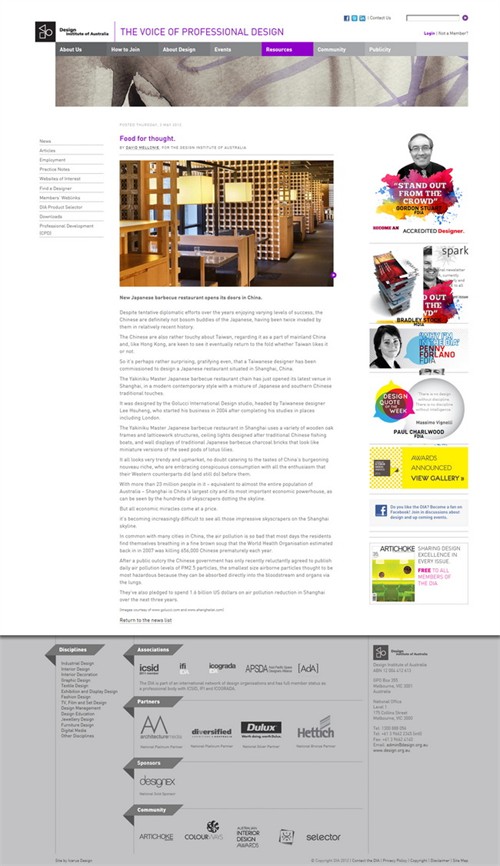The Design Institute of Australia 澳大利亚设计院 David Mellonie 以古鲁奇设计GOLUCCI INTERNATIONAL DESIGN 利旭恒餐厅设计作品烧肉达人YAKINIKU MASTER Shanghai 分析了中国社会百态~
http://www.golucci.com/User/News.aspx?a=5
http://www.dia.org.au/index.cfm?news=1768&id=101

Food for thought.
By David Mellonie, for the Design Institute of Australia
New Japanese barbecue restaurant opens its doors in China.
Despite tentative diplomatic efforts over the years enjoying varying levels of success, the Chinese are definitely not bosom buddies of the Japanese, having been twice invaded by them in relatively recent history.
The Chinese are also rather touchy about Taiwan, regarding it as a part of mainland China and, like Hong Kong, are keen to see it eventually return to the fold whether Taiwan likes it or not.
So it’s perhaps rather surprising, gratifying even, that a Taiwanese designer has been commissioned to design a Japanese restaurant situated in Shanghai, China.
The Yakiniku Master Japanese barbecue restaurant chain has just opened its latest venue in Shanghai, in a modern contemporary style with a mixture of Japanese and southern Chinese traditional touches.
It was designed by the Golucci International Design studio, headed by Taiwanese designer Lee Hsuheng, who started his business in 2004 after completing his studies in places including London.
The Yakiniku Master Japanese barbecue restaurant in Shanghai uses a variety of wooden oak frames and latticework structures, ceiling lights designed after traditional Chinese fishing boats, and wall displays of traditional Japanese barbecue charcoal bricks that look like miniature versions of the seed pods of lotus lilies.
It all looks very trendy and upmarket, no doubt catering to the tastes of China’s burgeoning nouveau riche, who are embracing conspicuous consumption with all the enthusiasm that their Western counterparts did (and still do) before them.
With more than 23 million people in it – equivalent to almost the entire population of Australia – Shanghai is China’s largest city and its most important economic powerhouse, as can be seen by the hundreds of skyscrapers dotting the skyline.
But all economic miracles come at a price.
it’s becoming increasingly difficult to see all those impressive skyscrapers on the Shanghai skyline.
In common with many cities in China, the air pollution is so bad that most days the residents find themselves breathing in a fine brown soup that the World Health Organisation estimated back in in 2007 was killing 656,000 Chinese prematurely each year.
After a public outcry the Chinese government has only recently reluctantly agreed to publish daily air pollution levels of PM2.5 particles, the smallest size airborne particles thought to be most hazardous because they can be absorbed directly into the bloodstream and organs via the lungs.
They’ve also pledged to spend 1.6 billion US dollars on air pollution reduction in Shanghai over the next three years.
(Images courtesy of www.golucci.com and www.shanghaiist.com)






所有评论